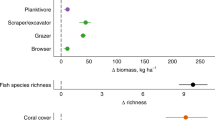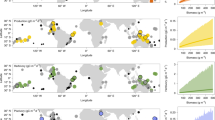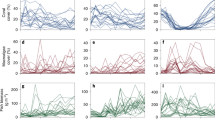Abstract
Climate-induced coral bleaching is among the greatest current threats to coral reefs, causing widespread loss of live coral cover1. Conditions under which reefs bounce back from bleaching events or shift from coral to algal dominance are unknown, making it difficult to predict and plan for differing reef responses under climate change2. Here we document and predict long-term reef responses to a major climate-induced coral bleaching event that caused unprecedented region-wide mortality of Indo-Pacific corals. Following loss of >90% live coral cover, 12 of 21 reefs recovered towards pre-disturbance live coral states, while nine reefs underwent regime shifts to fleshy macroalgae. Functional diversity of associated reef fish communities shifted substantially following bleaching, returning towards pre-disturbance structure on recovering reefs, while becoming progressively altered on regime shifting reefs. We identified threshold values for a range of factors that accurately predicted ecosystem response to the bleaching event. Recovery was favoured when reefs were structurally complex and in deeper water, when density of juvenile corals and herbivorous fishes was relatively high and when nutrient loads were low. Whether reefs were inside no-take marine reserves had no bearing on ecosystem trajectory. Although conditions governing regime shift or recovery dynamics were diverse, pre-disturbance quantification of simple factors such as structural complexity and water depth accurately predicted ecosystem trajectories. These findings foreshadow the likely divergent but predictable outcomes for reef ecosystems in response to climate change, thus guiding improved management and adaptation.
This is a preview of subscription content, access via your institution
Access options
Subscribe to this journal
Receive 51 print issues and online access
$199.00 per year
only $3.90 per issue
Buy this article
- Purchase on Springer Link
- Instant access to full article PDF
Prices may be subject to local taxes which are calculated during checkout




Similar content being viewed by others
References
Hoegh-Guldberg, O. et al. Coral reefs under rapid climate change and ocean acidification. Science 318, 1737–1742 (2007)
Hughes, T. P., Graham, N. A. J., Jackson, J. B. C., Mumby, P. J. & Steneck, R. S. Rising to the challenge of sustaining coral reef resilience. Trends Ecol. Evol. 25, 633–642 (2010)
Goreau, T., McClanahan, T., Hayes, R. & Strong, A. Conservation of coral reefs after the 1998 global bleaching event. Conserv. Biol. 14, 5–15 (2000)
Gilmour, J. P., Smith, L. D., Heyward, A. J., Baird, A. H. & Pratchett, M. S. Recovery of an isolated coral reef system following severe disturbance. Science 340, 69–71 (2013)
Sheppard, C. R. C., Harris, A. & Sheppard, A. L. S. Archipelago-wide coral recovery patterns since 1998 in the Chagos Archipelago, central Indian Ocean. Mar. Ecol. Prog. Ser. 362, 109–117 (2008)
Hughes, T. P. Catastrophes, phase shifts, and large-scale degradation of a Caribbean coral reef. Science 265, 1547–1551 (1994)
Mumby, P. J. et al. Fishing, trophic cascades, and the process of grazing on coral reefs. Science 311, 98–101 (2006)
Roff, G. & Mumby, P. J. Global disparity in the resilience of coral reefs. Trends Ecol. Evol. 27, 404–413 (2012)
McCook, L. J. et al. Adaptive management of the Great Barrier Reef: A globally significant demonstration of the benefits of networks of marine reserves. Proc. Natl Acad. Sci. USA 107, 18278–18285 (2010)
Mora, C. & Sale, P. F. Ongoing global biodiversity loss and the need to move beyond protected areas: a review of the technical and practical shortcomings of protected areas on land and sea. Mar. Ecol. Prog. Ser. 434, 251–266 (2011)
Saji, N. H., Goswami, B. N., Vinayachandran, P. N. & Yamagata, T. A dipole mode in the tropical Indian Ocean. Nature 401, 360–363 (1999)
Ateweberhan, M., McClanahan, T. R., Graham, N. A. J. & Sheppard, C. R. C. Episodic heterogeneous decline and recovery of coral cover in the Indian Ocean. Coral Reefs 30, 739–752 (2011)
Graham, N. A. J. et al. Dynamic fragility of oceanic coral reef ecosystems. Proc. Natl Acad. Sci. USA 103, 8425–8429 (2006)
Mouillot, D., Graham, N. A. J., Villéger, S., Mason, N. W. H. & Bellwood, D. R. A functional approach reveals community responses to disturbances. Trends Ecol. Evol. 28, 167–177 (2013)
Chong-Seng, K. M., Graham, N. A. J. & Pratchett, M. S. Bottlenecks to coral recovery in the Seychelles. Coral Reefs 33, 449–461 (2014)
Smith, J. E. et al. Indirect effects of algae on coral: algae-mediated, microbe-induced coral mortality. Ecol. Lett. 9, 835–845 (2006)
Graham, N. A. J. & Nash, K. L. The importance of structural complexity in coral reef ecosystems. Coral Reefs 32, 315–326 (2013)
Rogers, A., Blanchard, J. L. & Mumby, P. J. Vulnerability of coral reef fisheries to a loss of structural complexity. Curr. Biol. 24, 1000–1005 (2014)
McCook, L. J. Macroalgae, nutrients and phase shifts on coral reefs: scientific issues and management consequences for the Great Barrier Reef. Coral Reefs 18, 357–367 (1999)
Bridge, T. C. L., Hughes, T. P., Guinotte, J. M. & Bongaerts, P. Call to protect all coral reefs. Nature Climate Change 3, 528–530 (2013)
Bellwood, D. R., Hughes, T. P., Folke, C. & Nystrom, M. Confronting the coral reef crisis. Nature 429, 827–833 (2004)
Lokrantz, J., Nyström, M., Thyresson, M. & Johansson, C. The non-linear relationship between body size and function in parrotfishes. Coral Reefs 27, 967–974 (2008)
McClanahan, T. R. et al. Critical thresholds and tangible targets for ecosystem-based management of coral reef fisheries. Proc. Natl Acad. Sci. USA 108, 17230–17233 (2011)
Lapointe, B. E. Nutrient thresholds for bottom-up control of macroalgal blooms on coral reefs in Jamaica and southeast Florida. Limnol. Oceanogr. 42, 1119–1131 (1997)
Atkinson, M. J. & Smith, S. V. C:N:P ratios of benthic marine plants. Limnol. Oceanogr. 26, 1074–1083 (1983)
Smith, J. E., Smith, C. M. & Hunter, C. L. An experimental analysis of the effects of herbivory and nutrient enrichment on benthic community dynamics on a Hawaiian reef. Coral Reefs 19, 332–342 (2001)
Burkepile, D. E. et al. Chemically mediated competition between microbes and animals: microbes as consumers in food webs. Ecology 87, 2821–2831 (2006)
Selig, E. R. & Bruno, J. F. A global analysis of the effectiveness of marine protected areas in preventing coral loss. PLoS ONE 5, e9278 (2010)
Cinner, J. E. et al. Gear-based fisheries management as a potential adaptive response to climate change and coral mortality. J. Appl. Ecol. 46, 724–732 (2009)
Adger, W. N., Hughes, T. P., Folke, C., Carpenter, S. R. & Rockström, J. Social-ecological resilience to coastal disasters. Science 309, 1036–1039 (2005)
Wilson, S. K., Graham, N. A. J. & Polunin, N. V. C. Appraisal of visual assessments of habitat complexity and benthic composition on coral reefs. Mar. Biol. 151, 1069–1076 (2007)
Graham, N. A. J. et al. Lag effects in the impacts of mass coral bleaching on coral reef fish, fisheries, and ecosystems. Conserv. Biol. 21, 1291–1300 (2007)
Letourneur, Y., Kulbicki, M. & Labrosse, P. Length–weight relationship of fishes from coral reefs and lagoons of New Caledonia: an update. Naga, the ICLARM Quarterly 21, 39–46 (1998)
Froese, R. & Pauly, D. FishBase (http://www.fishbase.org) (2011)
Wilson, S. K. et al. Exploitation and habitat degradation as agents of change within coral reef fish communities. Glob. Change Biol. 14, 2796–2809 (2008)
Burkepile, D. E. et al. Nutrient supply from fishes facilitates macroalgae and suppresses corals in a Caribbean coral reef ecosystem. Sci. Rep. 3, 1493 (2013)
Ateweberhan, M., Bruggemann, J. H. & Breeman, A. M. Seasonal dynamics of Sargassum ilicifolium (Phaeophyta) on a shallow reef flat in the southern Red Sea (Eritrea). Mar. Ecol. Prog. Ser. 292, 159–171 (2005)
Umezawa, Y., Miyajima, T., Yamamuro, M., Kayanne, H. & Koike, I. Fine-scale mapping of land-derived nitrogen in coral reefs by δ15N in macroalgae. Limnol. Oceanogr. 47, 1405–1416 (2002)
Wooldridge, S., Brodie, J. & Furnas, M. Expoure of inner-shelf reefs to nutrient enriched runoff entering the Great Barrier Reef Lagoon: Post-European changes and the design of water quality targets. Mar. Pollut. Bull. 52, 1467–1479 (2006)
Ekebom, J., Laihonen, P. & Suominen, T. A GIS-based step-wise procedure for assessing physical exposure in fragmented archipelagos. Estuar. Coast. Shelf Sci. 57, 887–898 (2003)
Chollett, I. & Mumby, P. J. Predicting the distribution of Montastrea reefs using wave exposure. Coral Reefs 31, 493–503 (2012)
Wessel, P. & Smith, W. H. F. GSHHG – A Global Self-consistent, Hierarchical, High-resolution Geography Database. http://www.ngdc.noaa.gov/mgg/shorelines/gshhs.html (2014)
Rohweder, J. et al. Application of wind fetch and wave models for habitat rehabilitation and enhancement projects – 2012 update. http://www.umesc.usgs.gov/management/dss/wind_fetch_wave_models_2012update.html (2012)
Kramer, D. L. & Chapman, M. R. Implications of fish home range size and relocation for marine reserve function. Environ. Biol. Fishes 55, 65–79 (1999)
Nash, K. L., Graham, N. A. J. & Bellwood, D. R. Fish foraging patterns, vulnerability to fishing, and implications for the management of ecosystem function across scales. Ecol. Appl. 23, 1632–1644 (2013)
McGill, B. J., Enquist, B. J., Weiher, E. & Westoby, M. Rebuilding community ecology from functional traits. Trends Ecol. Evol. 21, 178–185 (2006)
Legendre, P. & Legendre, L. Numerical Ecology 2nd edn (Elsevier, 1998)
Villéger, S., Mason, N. W. H. & Mouillot, D. New multidimensional functional diversity indices for a multifaceted framework in functional ecology. Ecology 89, 2290–2301 (2008)
Coker, D., Wilson, S. K. & Pratchett, M. S. Importance of live coral habitat for reef fishes. Rev. Fish Biol. Fish. 24, 89–126 (2014)
Lester, S. E. et al. Biological effects within no-take marine reserves: a global synthesis. Mar. Ecol. Prog. Ser. 384, 33–46 (2009)
Fabricius, K. E. Effects of terrestrial runoff on the ecology of corals and coral reefs: review and synthesis. Mar. Pollut. Bull. 50, 125–146 (2005)
Loya, Y. et al. Coral bleaching: the winners and the losers. Ecol. Lett. 4, 122–131 (2001)
Pratchett, M. S. et al. Effects of climate-induced coral bleaching on coral-reef fishes: ecological and economic consequences. Oceanogr. Mar. Biol. Annu. Rev. 46, 251–296 (2008)
Patil, A. et al. PyMC: Bayesian stochastic modelling in Python. J. Stat. Softw. 35, 1–81 (2010)
Cheal, A. J., Emslie, M., MacNeil, M. A., Miller, I. & Sweatman, H. Spatial variation in the functional characteristics of herbivorous fish communities and the resilience of coral reefs. Ecol. Appl. 23, 174–188 (2013)
Graham, N. A. J. et al. Climate warming, marine protected areas and the ocean-scale integrity of coral reef ecosystems. PLoS ONE 3, e3039 (2008)
Wilson, S. K. et al. Exploitation and habitat degradation as agents of change within coral reef fish communities. Glob. Change Biol. 14, 2796–2809 (2008)
McClanahan, T. R., Ateweberhan, M., Darling, E. S., Graham, N. A. J. & Muthiga, N. A. Biogeography and change among regional coral communities across the western Indian Ocean. PLoS ONE 9, e93385 (2014)
Jennings, S., Grandcourt, E. M. & Polunin, N. V. C. The effects of fishing on the diversity, biomass and trophic structure of Seychelles’ reef fish communities. Coral Reefs 14, 225–235 (1995)
Wilson, S. K. et al. Effect of macroalgal expansion and marine protected areas on coral recovery following a climatic disturbance. Conserv. Biol. 26, 995–1004 (2012)
Sheppard, C. R. C., Spalding, M., Bradshaw, C. & Wilson, S. Erosion vs. recovery of coral reefs after 1998 El Niño: Chagos reefs, Indian Ocean. Ambio 31, 40–48 (2002)
Mumby, P. J. et al. Empirical relationships among resilience indicators on Micronesian reefs. Coral Reefs 32, 213–226 (2013)
Cheal, A. J. et al. Coral-macroalgal phase shifts or reef resilience: links with diversity and functional roles of herbivorous fishes on the Great Barrier Reef. Coral Reefs 29, 1005–1015 (2010)
Burkepile, D. E. & Hay, M. E. Herbivore species richness and feeding complementarity affect community structure and function on a coral reef. Proc. Natl Acad. Sci. USA 105, 16201–16206 (2008)
Rasher, D. B., Hoey, A. S. & Hay, M. E. Consumer diversity interacts with prey defenses to drive ecosystem function. Ecology 94, 1347–1358 (2013)
Mumby, P. J. & Harborne, A. R. Marine reserves enhance the recovery of corals on Caribbean reefs. PLoS ONE 5, e8657 (2010)
Burkepile, D. E. & Hay, M. E. Herbivore vs. nutrient control of marine primary producers: context-dependent effects. Ecology 87, 3128–3139 (2006)
Vergés, A., Vanderklift, M. A., Doropoulos, C. & Hyndes, G. A. Spatial patterns in herbivory on a coral reef are influenced by structural complexity but not by algal traits. PLoS ONE 6, e17115 (2011)
Carpenter, R. C. & Edmunds, P. J. Local and regional scale recovery of Diadema promotes recruitment of scleractinian corals. Ecol. Lett. 9, 271–280 (2006)
Madin, J. S. & Connolly, S. R. Ecological consequences of major hydrodynamic disturbances on coral reefs. Nature 444, 477–480 (2006)
Done, T. J. in Perspectives on Coral Reefs (eds. Barnes, D. J. & Clouston, B. ) Coral zonation, its nature and significance. 107–147 (Australian Institute of Marine Science, 1983)
Larned, S. T. & Atkinson, M. J. Effects of water velocity on NH4 and PO4 uptake and nutrient-limited growth in the macroalga Dictyosphaeria cavernosa. Mar. Ecol. Prog. Ser. 157, 295–302 (1997)
Graham, N. A. J. & McClanahan, T. R. The last call for marine wilderness? Bioscience 63, 397–402 (2013)
Graham, N. A. J., Chong-Seng, K. M., Huchery, C., Januchowski-Hartley, F. A. & Nash, K. L. Coral reef community composition in the context of disturbance history on the Great Barrier Reef, Australia. PLoS ONE 9, e101204 (2014)
Acknowledgements
This research was principally supported by the Australian Research Council (DP1094932, DE130101705), the Leverhulme Trust (F/00 125/M), and the Western Indian Ocean Marine Science Association. The Natural Environment Research Council (GR3/1154) funded work in Fiji. We thank the Seychelles Fishing Authority, Seychelles Marine Parks Authority, Nature Seychelles, and Seychelles National Meteorological Services for technical and logistical assistance. Many thanks to N. Polunin for support early in the project, to N. Cariglia for collecting the sea urchin data, to K. Chong-Seng for collecting the juvenile coral data, to C. Huchery for helping develop the wave exposure model, to J. Turner for photos a and b in Extended Data Fig. 1, and T. McClanahan and N. Dulvy for sharing data used in Extended Data Table 3 and Extended Data Fig. 5. J. Cinner, C. Hicks, K. Nash, and three anonymous referees provided useful comments on the manuscript.
Author information
Authors and Affiliations
Contributions
N.A.J.G. conceived of the study with S.K.W. and M.A.M.; N.A.J.G. S.J., and S.K.W. collected the data; N.A.J.G., M.A.M., and D.M. developed and implemented the analyses; N.A.J.G. led the manuscript with S.J., M.A.M., D.M., and S.K.W.
Corresponding author
Ethics declarations
Competing interests
The authors declare no competing financial interests.
Extended data figures and tables
Extended Data Figure 1 Changing condition of Seychelles coral reefs.
a, b, Coral reefs of the inner Seychelles were typified by high coral cover and low macroalgal cover in 1994. c, d, The 1998 coral bleaching event caused widespread coral loss, but some reefs maintained their structural complexity (c), while others collapsed (d) by 2005. e, f, In 2011, many reefs had recovered to high live coral cover (e), while others had undergone a regime shift to abundant macroalgal cover (f).
Extended Data Figure 2 Principal components analysis of benthic composition on 21 reefs across the inner Seychelles 1994–2011.
Reefs coloured blue are tracking back to pre-disturbance benthic composition in 2005–2011 following the 1998 bleaching event, whereas reefs coloured red are shifting to alternate benthic compositions, dominated by macroalgae (n = 84).
Extended Data Figure 3 Distance from pre-disturbance benthic community composition.
Euclidian distance in multivariate space, plotted against percent cover of dominant biotic benthic organisms (live coral in blue, macroalgae in red) (n = 63). a, 2005 data. b, 2008 data. c, 2011 data. Shading represents 95% confidence bounds for the mean trend lines of each habitat type.
Extended Data Figure 4 Changing coral and macroalgal cover is relation to pre-disturbance values.
a, Data for recovering reefs, where the change in coral cover compared to 1994 was reducing through time, whereas change in macroalgae remained stable (n = 42). b, Data for regime shifting reefs where the decline in coral cover persisted through time, and changes in macroalgae increased through time (n = 42).
Extended Data Figure 5 Comparison of effect size posterior density distributions for depth and initial structural complexity in predicting coral versus macroalgae outcomes post disturbance in Seychelles versus 6 other countries across the Indo-Pacific.
a, Depth effect size plot, dark blue posterior distribution for Seychelles, grey for other countries (n = 51). b, Initial structural complexity effect size plot, dark blue distribution for Seychelles, green for other countries (n = 14). Depth and structural complexity variables were standardized in both analyses before estimation and all posterior distributions have more than 95% of their density below zero.
Extended Data Figure 7 Map of study sites around the inner Seychelles.
Sites in blue are recovering from the 1998 mass bleaching event, whereas sites in red have undergone a regime shift to macroalgal cover.
Rights and permissions
About this article
Cite this article
Graham, N., Jennings, S., MacNeil, M. et al. Predicting climate-driven regime shifts versus rebound potential in coral reefs. Nature 518, 94–97 (2015). https://doi.org/10.1038/nature14140
Received:
Accepted:
Published:
Issue Date:
DOI: https://doi.org/10.1038/nature14140
This article is cited by
-
The recovery of octocoral populations following periodic disturbance masks their vulnerability to persistent global change
Coral Reefs (2024)
-
Transient dynamics mask the resilience of coral reefs
Theoretical Ecology (2024)
-
No coral recovery three years after a major bleaching event in reefs in the Southwestern Atlantic refugium
Marine Biology (2024)
-
Coral reefs benefit from reduced land–sea impacts under ocean warming
Nature (2023)
-
Asynchrony in coral community structure contributes to reef-scale community stability
Scientific Reports (2023)
Comments
By submitting a comment you agree to abide by our Terms and Community Guidelines. If you find something abusive or that does not comply with our terms or guidelines please flag it as inappropriate.



